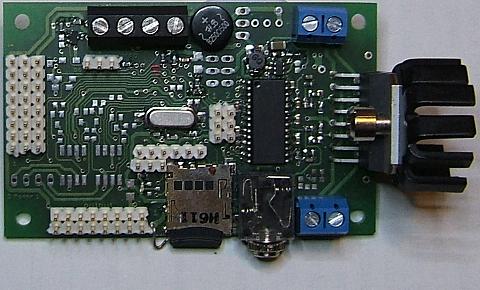OpenPlayer - OpenDecoder4 - Digital decoder for DCC
- under construction
Properties
- CPU AVR90can128
- DCC input including BiDi (RailCom ®)
- Slot for microSD cards
- Mp3 decoder chip with integrated DAC
- 3.5 mm jack and/or stereo amp with 2x10 watt output, speaker connectors with screw terminals
- Two (!) H-bridges with sensors for current measurement and load control (BEMF). Connection of two motors or a stepper motor.
- 8 switch outputs with ULN2803 (300mA), plugged with a standard 2.54 mm pin headers
- 8 inputs with 5V power supply option (for example, switches, encoders, sensors, photoelectric sensors), plugged with a standard 2.54 mm pin header
- Connector for graphic display 128x64 or text display including switching regulators for the LED backlighting.
- An additional power supply can be connected
- Double Servo Output
- Switching voltage regulators including linear post regulator for best audio quality, as an alternative normal linear regulators could be used.
- Firmware update via USB (using the FTDI-Cable TTL)
- CAN or XPressnet plugable. The decoder is realized on a PCB 50 x 80mm in size, two-sided and by using SMD components (0603).

OpenDecoder4 includes a lot of intelligence within the decoder and is therefore working with a large AVR processor. The hardware includes the following functional blocks:
Application
-
With these hardware function blocks a lot of control task can be performed within the decoder. Examples:
- SoundDecoder: playing mp3 files from internal memory of the atmel or from the SD card inserted on a DCC command.
- Stand alone mp3 player with control panel. (OpenPlayer)
- Electronic doorbell
- Crane controls, with input and supervision of the crane as using light sensors.
- Stepper motor controls, such as for hubs or turntables.
- Full function control of fairground models.
- DCC standalone command station.
mp3-Decoder
- CVxxx: Play-Mode
1 Standardplayer 2 Kirchenglocken
Standardplayer
-
Wenn CVxxx auf 1 eingestellt ist, dann agiert der Decoder als Standard mp3-Decoder.
Dabei wird auf DCC-Befehl bzw.
Parameter:
Fade In/out (Rampe)
LoopTimer (1,2,3, forever)
Definierter Hintergrundkanal (dieser wird immer dann durchgehend gespielt, wenn nichts anderes läuft)
Kirchturmdekoder
-
Wenn CVxxx auf 2 eingestellt ist, dann agiert der Decoder als Dekoder für Kirchenglocken.
Der Dekoder wertet die DCC-Uhr-Nachrichten aus und spielt bei Eintreffen einen dazu passenden Glockenschlag
ab.
Hierzu müssen auf der SD Karte die Soundfragmente für Viertelstundenschlag und Stundenschlag hinterlegt sein.
| Ton | Pfad |
|---|---|
| Viertelschlag | bell\quarter.mp3 |
| Stundenschlag | bell\hour.mp3 |
Der Decoder agiert nun folgendermaßen: Der DCC-Eingang wird auf Uhrzeitnachrichten abgehört, und z.B. um 9:45 wird dreimal quarter.mp3 gespielt. Um 10:00 wird folgendes abgespielt: 4 * quarter.mp3, 10 * hour.mp3
mögliche Parameter:
anderes Unterverzeichnis (bell<num>/quarter) (CV: SoundDir)
Ruhe in der Nacht (start hour, stop hour einstellbar)
Nur Stundenschlag, nur Halbstundenschlag (eine Glocke) (CV: Mode)
Uhr geht nach (CV: StartOffset)
Mittagsläuten, morgens, abends
Sonntagsläuten
Documents / Links
- DCC configuration variables including CV Calculator